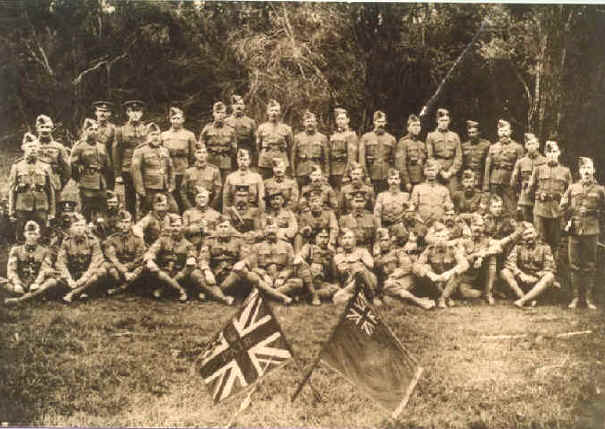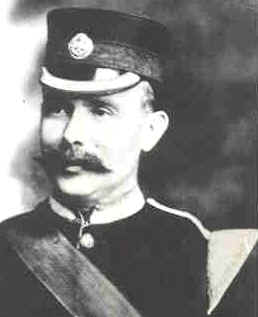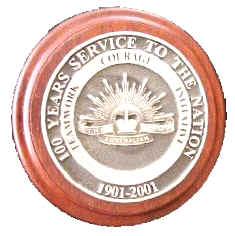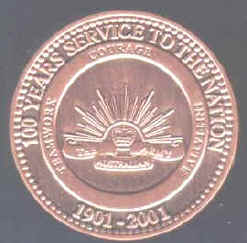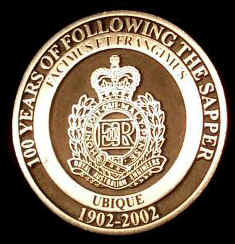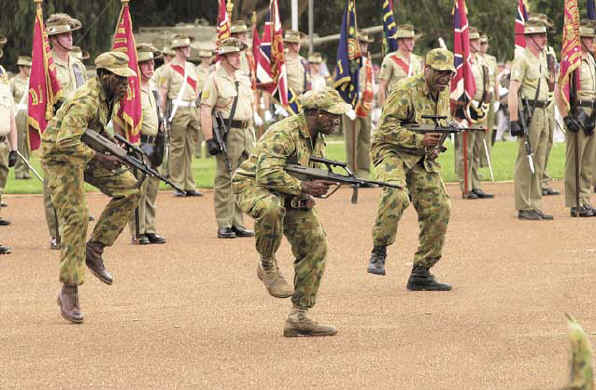 |
|
|||
|
Sovereign's & Regimental Colours in Australia |
||
|
|
||
|
|
Happy 100th Birthday, ARMY. |
||||||||
|
Every Colour, Standard, Banner and Guidon currently in service, parading together for the first time since the Queen’s Silver Jubilee in 1977, added to the sense of occasion. |
||||||||
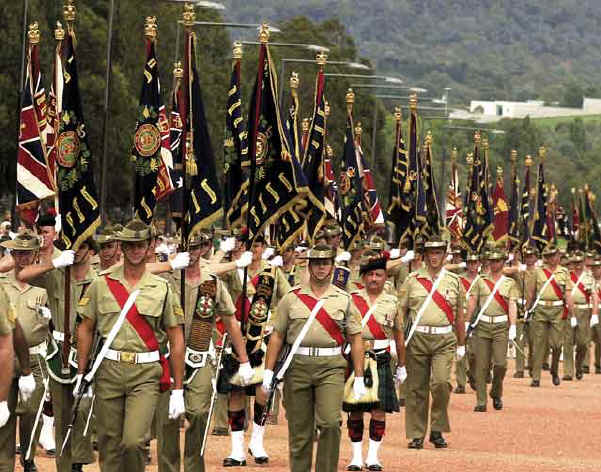 |
||||||||
| The Australian Army put
its best foot forward on March 10, 2001 when more than 1000 soldiers and
veterans marched in the nation’s capital in a spectacular show of
force to mark the Centenary of Army.
It was far more than just a military march-past, however, with colourfully choreographed sequences and historical segments highlighting the role of the army in serving the nation from South Africa to East Timor and beyond.
Every Colour, Standard, Banner and Guidon currently in service, parading together for the first time since the Queen’s Silver Jubilee in 1977, added to the sense of occasion. An RMC honour guard, Aboriginal and Torres Strait Islander troops conducting traditional warrior dances, heritage troops showcasing the army of old, massed bands, vehicles and aircraft added to the spectacle. As a huge crowd of spectators gathered along Anzac Parade and in front of the AWM, a pipers’ lament, signifying the sorrow of lives lost in service of the nation, set a somber mood. The Army Banner, a birthday gift from the people of Australia, was marched into position and placed on the Stone of Remembrance shortly before the parade proper commenced under the command of Maj-Gen Peter Leahy.
Parade host Lt-Gen Peter Cosgrove welcomed the Prime Minister and Governor General on parade before inviting them to inspect the Guard of Honour. With all in readiness, the pomp and circumstance of one of the biggest, most colourful and most significant military parades in recent years stepped off. Led by soldiers in the uniforms of the mounted troops of the Boer War and WW1, the procession showcased the uniforms of all conflicts up to the present. Next came the Colours, Banners and Guidons. These most precious insignia, inscribed with the campaign and battle honours of their units, represent the soul of each unit or regiment and of their heroes killed in action. Once assembled, the colour parties, heritage troops and four full guards performed a massed Royal Salute while Black Hawk, Iroquois and Kiowa helicopters from the Army’s Aviation Regiments flew low overhead.
As a tribute to the service of
Aboriginal and Torres Strait Islanders in peace and war, indigenous
soldiers from 51FNQR performed The Steyr Dance — a traditional spear
dance adapted by the soldiers to incorporate their Steyr rifles. Prime Minister John Howard said that as the nation celebrated this great year of centenary we would mark and honour many things but there was no group in Australian society to whom more was owed than to those who had fought, died and suffered in the defence of this country. “We come today to give thanks as a
nation to what the personnel of the Australian Army over the past 100
years has done to give us the life, the peace, the security and the
contentment we now, as a nation, enjoy,” Mr. Howard said. “Let me thank all of you, the men and women of the Australian Army, for what you have done. And let me give you a pledge on behalf of all of the peoples of Australia - you will always be honoured, you will always be respected and you will always have a very special place in the hearts and in the minds of our nation.” Governor General Sir William Dean then presented the new Army Banner to RSM-A WO Pedro Rosemond on behalf of a grateful nation as a symbol of sacrifice, loyalty and devotion to duty in the service of Australia. “Your Excellency, on behalf of a grateful army, we accept this banner with pride and honour. And to you and to all Australians I say, on behalf of all diggers — thanks mate,” WO Rosemond said in reply, to the delight of the huge crowd. After the banner was marched into position on the parade ground, the four full guards on parade fired volleys in the ripple-effect drill movement known as Fieu de Joie or Joy of Sound. As the last rifle fired, artillery answered with a 19-gun salute before the massed army bands rendered Happy Birthday in deference to the whole intent of the parade. Lt-Gen Cosgrove then invited official guests to join him in laying wreaths at the Tomb of the Unknown Soldier, bringing the parade to an end with the reminder that our young nation has paid a great price for its freedom. March 15, 2001 from ARMY News |
||||||||
